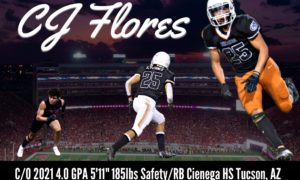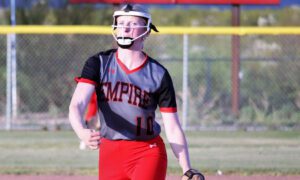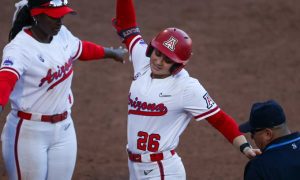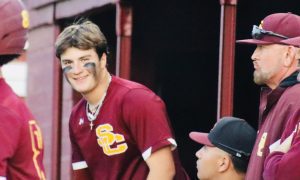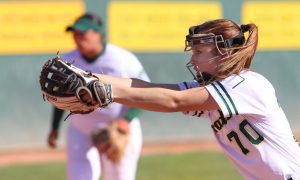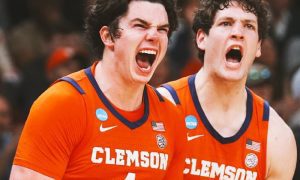
NOTE: Check out previous UA-ASU memories from former Arizona Wildcats by clicking here
[ezcol_1half id=”” class=”” style=””]
ARIZONA PLAYER MEMORIES
Max Zendejas made this game-winning 45 yarder at ASU as time expired in 1983
MAX ZENDEJAS, placekicker
“What I remember most is playing against my brother Luis and watching my dad switching hats after kicking the game-winning field goal and putting them out of the Rose Bowl. The 45-yard kick to beat ASU in 1983 and the 57-yarder which beat ASU in Tempe in 1985 are also what I remember. I broke that last record I neede to brake (actually tying Lee Pistor with the longest field goal in school history).”STEVE JUSTICE, long snapper
“Being a part of all those kicks Max made is memorable. Also being a part of that punt in 1985 that Byron Evans forced the fumble and Don Be’Ans recovered in the end zone for the TD!”PAUL TOFFLEMIRE, center
“My greatest experience would have to be the ’89 season. The game was up in Tempe. The nose guard was All-Pac-10 (Dan Saleaumua) and he was bragging about how he & the D-line would change the outcome of the game. The O-line just kicked their asses. It was the biggest crowd in Sun Devil Stadium at the time and they wore their yellow uniforms & looked like a bunch of bananas running around!!!”LAMONTE HUNLEY, linebacker
“The greatest memory of this great game is the start of “The Streak” (in 1982). I’m proud to have been a part of that great team.”
[/ezcol_1half]
[ezcol_1half_end id=”” class=”” style=””]
RIVALRY’S FIVE GREATEST GAMES
Series record: Arizona leads 47-38-1. Since “The Streak” ended in 1990, the UA is 10-12 against the Sun Devils. The visiting team has won in the last four years.
5. ASU 30, Arizona 7, Arizona Stadium, Nov. 30, 1968
The “Ultimatum Bowl” as it became to be known is the game that ignited the idea of the Fiesta Bowl and, as a result, produced future national championship football games in Phoenix. ASU (7-2) and Arizona (8-1) were about to meet in the Territorial Cup game. The Wildcats were coming off a significant 14-7 victory over No. 20 Wyoming the week before.
Officials of the Sun Bowl intended to invite the winner of the ASU-UA game to the El Paso bowl game. Instead, UA coach Darrell Mudra issued his infamous ultimatum: Take us now or don’t take us at all and we’ll shop for other bowls. The Sun Bowl officials buckled to his demand and offered Arizona its 1968 invitation before the motivated Sun Devils routed the Wildcats in Tucson.
The Ultimatum Bowl led to the successful Fiesta Bowl because Phoenix officials wanted to create their own bowl game to avoid what happened to the Sun Devils in 1968. The Fiesta Bowl began in 1971. ASU played in four of the first five games (winning four). By then, the Fiesta Bowl had been established nationally and financially. Arizona played Auburn in the 1968 Sun Bowl and lost 34-10.
4. Arizona 16, ASU 13, Sun Devil Stadium, Nov. 13, 1985
Poor John Cooper.
Yes, the former ASU coach guided the Sun Devils to their first Rose Bowl appearance in 1986, but he never beat the Arizona Wildcats in three tries. In the season Cooper and ASU went to the Rose Bowl, the Wildcats dominated the Sun Devils at Arizona Stadium in a 34-17 win. In the season after in Tempe, all the Sun Devils had to do was get a punt off in the waning seconds to beat the Wildcats. The punter fumbled and Arizona tied the game on a field goal to extend “The Streak” to six games without a loss to the Sun Devils. Cooper then left to Ohio State.
[/ezcol_1half_end]
[ezcol_1half id=”” class=”” style=””]
WARNER SMITH, offensive lineman
“My best memory of the ASU game was from 1993. We were at our absolute low point. We had just blown our shot at the Rose Bowl against Cal and we were decimated by injuries. If ASU won, I think there were supposed to go to the Sun Bowl. If we won, the rumor was that we’d get another crack at Miami in the Fiesta Bowl. Chuck Cecil spoke to the team the night before the game at our hotel in Tempe. He was INTENSE!! ‘Reach down the devil’s throat, grab his little tiny heart, and CRUSH him!!’ It felt like Braveheart!! We could’ve played the game in the hotel parking lot. No one slept that night. The game was a three-hour brawl. Desert Swarm thumped Jake Plummer. Dan White sliced through the scummies like a surgeon. Afterwards, sure enough, Fiesta Bowl representatives were in our locker room to tell us we were going to face the Miami Hurricanes on New Years Day.”DAVID ADAMS, running back
“My greatest UA-ASU memory is going 5-0 (against ASU) during my years at the U! Plus, when you run into some the A-State players and they cant say a damn word!”
BRANT BOYER, linebacker
“The way our team came together and played in Tempe my senior year (in 1993). We had just lost at Cal so we couldn’t go to the Rose Bowl. A lot of teams would have shut it down, but we stuck together and gave Sparky a beating in his own house the next week that put us in the Fiesta Bowl versus Miami.”JAY DOBYNS, receiver
“Greatest memory: Coach (Larry) Smith crying after the ’82 game. That game was so important to him and his passion for it was contagious.”
DOUG PFAFF, placekicker
“My greatest memory of the rivalry was in the 1989 game, Tempe Normal came out after pregame in new all yellow uniforms as a way to motivate them and break the streak of victories UA was enjoying. Well it didn’t work. UA beat them in their stadium and the streak continued. Pretty sad to think that a uniform change after pregame warmups, to a new uniform would help you play better.”GEORGE MIHALOPOULOS, tight end
“Chuck’s pick six in ’86 is one of the greatest plays in UA history. That and the James DeBow tackle on the goal line on 4th down broke ASU’s back that year. In 1988, my senior year Derek ‘Thrill’ Hill had a huge touchdown at the end of the half, ‘Big Ben Right’ was the play. Ron Veal threw the pass 60-70 yards to the end zone. Melvin Smith, Kip Lewis and Hill were there waiting on it, it was tipped and Hill snagged it for the score. Final: 28-18 good guys!”
[/ezcol_1half]
[ezcol_1half_end id=”” class=”” style=””]
The fourth game in “The Streak” — Arizona’s unlikely win in 1985 — happened because of the foot of place-kicker Max Zendejas and the questionable play calling of Cooper (who was in his first season in Tempe).
All the Sun Devils needed was a tie against Arizona to advance to the Rose Bowl after they learned that first-place UCLA lost earlier in the day to USC. ASU, 8-2 and on a six-game winning streak, appeared headed to Pasadena with the game tied at 13-13 and 3:30 remaining in the fourth quarter. The Sun Devils had possession after advancing 12 yards from its 20 to the 32.
Cooper called a running play on first down to eat some more clock. But instead of executing at least two running plays to chew up more clock, Cooper went with the high-risk choices of passing on second and third down. The risk backfired. After quarterback Jeff Van Raaphorst threw an incompletion on second down, Arizona nose guard Stan Mataele sacked Van Raaphorst and caused a fumble, which Mataele recovered at the ASU 20.
That gave Zendejas, who earlier drilled one from 57 yards, the opportunity to make a game-winning 32-yard field goal with 1:43 left as the Wildcats prevented their rivals from the Rose Bowl for the second time in four years. ASU also needed at least a tie in 1982 to advance to the Rose Bowl under Darryl Rogers but lost 28-18 in Tucson — the beginning of “The Streak”.
3. ASU 24, Arizona 21, Sun Devil Stadium, Nov. 29, 1975
If only they had instant replay back in the 1970s, then we would know for sure if “The Catch” is really “The Catch”. That’s what ASU fans call John Jefferson’s diving touchdown reception in the back of the end zone in the 1975 thriller, which had the most implications for both teams than any Arizona-ASU game to date.
Hard to believe: There was no live television (cable and satellite TV were not around back then) of this showdown in Tempe despite the fact that ASU was 10-0 and ranked No. 8 in the nation while Arizona was 9-1 and ranked No. 12. A trip to the Fiesta Bowl for the teams, as the WAC champion, was on the line. The Tucson Daily Citizen reported that 8,000 viewed a closed-circuit telecast of the game in Tempe and at McKale Center.

The front page of the Tucson Citizen sports section tells it all after Arizona’s loss to ASU in 1975
Most of what we have of “The Catch” are inconclusive grainy photos of Jefferson outstretched with the ball in his hands before he hits the ground. Did he trap it? Does he cradle the ball in his hands, preventing it from grazing the ground?
[/ezcol_1half_end]
With the Wildcats leading 14-3 in the first half, the Sun Devils drove to the Arizona eight-yard line. ASU quarterback Dennis Sproul dropped back, found Jefferson running a slant to the right. His pass sailed long in the end zone but Jefferson dived for the ball like a center fielder leaping Superman-style for a scorching fly ball. After some refs showed indecision, they ruled that Jefferson did not trap the ball and awarded the Sun Devils a touchdown.
ASU fans call Jefferson’s catch the greatest play in Sun Devil history. Arizona fans still want to believe they are in the middle of a nightmare and the replay official has yet to make a ruling.
The Citizen’s Steve Weston reported “The Catch” this way: “Jefferson dived for the ball in the end zone and lost it when he hit the ground. Field judge Doug Reeves ruled it a TD catch, though other officials at first spotted the ball back on the original line of scrimmage, UA’s eight-yard line.”
Overlooked, because of Jefferson’s controversial catch, was a 77-yard touchdown reception by Arizona receiver Scott Piper in the first quarter that was questionably called back by the refs. Piper was ruled to have lined up off sides.
“I’ll look back on this game, not on the others,” UA quarterback Bruce Hill was quoted as saying by the Tucson Citizen in a somber locker room, reflecting on Arizona’s 9-2 season. “This was the season. We shouldn’t have won the others if we weren’t going to win this one.”
2. Arizona 28, ASU 18, Arizona Stadium, Nov. 27, 1982
ASU was so confident about winning this game that it showed up to Arizona Stadium with its maroon jerseys, which the Sun Devils wear in the comforts of Sun Devil Stadium. Arizona warmed up in its blue jerseys but was forced to wear its road white jerseys because of what ASU reportedly called a communication error.
Given the circumstance of ASU’s dominance in the series at that point and the Wildcats’ struggles, the Sun Devils probably felt like they could do just about anything.
ASU (9-1) needed a victory to make its first Rose Bowl despite being in the Pac-10 only five years after leaving the Western Athletic Conference with Arizona. The Sun Devils were ranked No. 6 with the nation’s top-rated defense, anchored by menacing linebacker Vernon Maxwell.
ASU was also on a 15-2 run against Arizona.
Smith, who passed away from leukemia in 2008, told The Arizona Daily Star’s Greg Hansen in a 1996 column that the 1982 victory over ASU — which started “The Streak” of nine consecutive games without a loss to the Sun Devils – was his most important win as coach of the Wildcats.
“People always asked me what my greatest victory was, and after we beat Notre Dame (in ’82) I had a game ball painted with `The Greatest Win’ put on the side,” Smith told Hansen. “That was the most prestigious win we had at Arizona, but the most important win was that ’82 game against Arizona State.
“That turned the tide within the state, something that had been a negative factor in Arizona football for 20 or 30 years. And it wasn’t just a one-game thing. We were able to maintain our edge from that game and keep it. In terms of how valuable a game was, that was the one. I can still see old Brian Holland running down the field.”
With the game scoreless early in the second quarter, Holland, a junior tailback, and Tunnicliffe hooked up in one of the most memorable pass receptions in the program’s history.
Arizona faced a third-and-8 at its own 8 against ASU’s blitzing defense. UA offensive coordinator Steve Axman called for a quick drop by Tom Tunnicliffe, with Holland going against man coverage against linebacker Mark Hicks. Tunnicliffe successfully read a safety blitz, released the ball before getting hit by two defenders, and hit Holland on stride over the middle at the 25.
Holland ran untouched to the endzone and the Wildcats led 7-0. The 92-yard touchdown pass tied the Arizona record, set in 1972 when Bill Demory connected with Charlie McKee in a 1972 game against BYU.
Tunnicliffe also became the school’s career passing leader in the game. He increased his career passing yards to 5,144. He also hit Brad Anderson with a 65-yard touchdown pass in the third quarter on a similar blitz read as the play to Holland.
1. Arizona 34, Arizona 17, Arizona Stadium, Nov. 22, 1986
“You Can’t Smell Roses With A Broken Nose”
An Arizona fan lofted that sign high in Arizona Stadium as the Wildcats were delivering a knockout blow of historical proportions.
The punch that put an exclamation point on the victory was Chuck Cecil’s 106-yard interception for a touchdown early in the fourth quarter. The play, officially listed at 100 yards, is the greatest play in the history of the program.
The Sun Devils were 9-0-1 entering the game, already clinching a spot in their first Rose Bowl, and were challenging for a national championship. The Wildcats (7-2) had not beaten their arch-rivals this convincingly since 1964 when Jim LaRue’s team pounded Frank Kush’s 8-1 team 30-6 in Tucson.
The victory was the fifth straight by the Wildcats over their archrival during “The Streak” and earned them a berth in the Aloha Bowl against North Carolina, in which they won to notch their first bowl victory in school history.
An over-capacity crowd of 58,267 — the second-largest ever at Arizona Stadium at the time — saw the Wildcats convert four ASU turnovers into 24 points, highlighted by Cecil’s return. His interception of a Jeff Van Raaphorst pass tied an NCAA record at 100 yards although he caught it six yards deep in the end zone. Under NCAA rules, interceptions inside the end zone are measured from the goal line.
“I just ran,” Cecil told the Tucson Citizen years later. “I still, to this day, don’t know why I ran it out.”
Lost through the years over the hyperbole of Cecil’s interception is the pass rush on Van Raaphorst, including that of tackle George Hinkle from the left side and nose guard Jim Birmingham up the middle. Hinkle and Birmingham put pressure on the ASU quarterback to hurry his throw toward Aaron Cox into coverage.
After Arizona took a 21-10 lead on the opening possession of the third quarter, the Sun Devils drove as far as the Wildcats 3. However, three carries by Channing Williams only got Arizona State to the 1.
Kent Bostrom then kicked an 18-yard field goal, but the Wildcats were flagged for too many men on the field. ASU coach John Cooper elected to take the points off the board and went for the touchdown. The move by Cooper, winless in three games against Arizona as ASU’s coach, backfired because of an other highlight defensive play, this one by linebacker James DeBow.
On fourth-and-inches, Williams was stopped just short of the goal line by DeBow, who held up Williams’ penetration long enough for his teammates to join to prevent the touchdown. DeBow weighed 195 pounds compared to Williams, who tipped the scale at 216.
WILDABOUTAZCATS.net publisher, writer and editor Javier Morales is a former Arizona Press Club award winner. He also writes articles for Bleacher Report, Lindy’s College Sports and TucsonCitizen.com.
[rps-paypal]
|
|





















